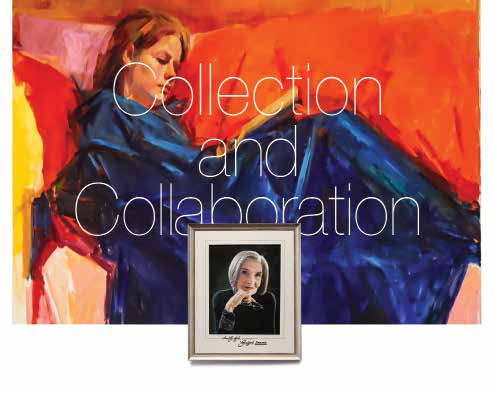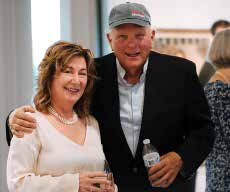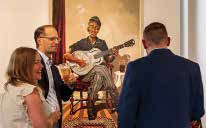COLLECTION AND COLLABORATION

The Griffith Fine Art Museum at Red Oak Brewery
By Cynthia Adams
One day, Bill Sherrill said, ‘I need you here tomorrow at 1:30 on the dot.’ Was he firing me?” wondered Red Oak’s Anne Griffith. Due to illness, she had worked remotely even prior to COVID.
But now she was worried.
She found him “sitting at the sidewalk waiting for us to drive up.” A group stood outside the Lager Haus entrance where a large tarp concealed a sign.
With Griffith watching, fellow employee Joe Rickman stepped up, pulling the tarp away. She was shocked into speechlessness.
The sign proclaimed the future home of the Griffith Fine Art Museum.
The new museum was a testament to many things, including a collaboration between long-time friends.
“Bill had refused to put his name on it,” Griffith recalls thinking. “I didn’t deserve it. He did. He had purchased it. It’s his collection. I feel like I didn’t do anything.” While she insists Sherrill had spent far longer collecting, even before knowing her, he argues that she shaped and refined his focus.
Sherrill is adamant. “Bullshit. I couldn’t have done it without her.” As his long-time art advisor, Griffith, who began working with Sherrill 30 years ago, was due the honor. Working in tandem, Griffith and Sherrill sourced more than 500 works of art, excluding sculptures displayed in the biergarten between the two buildings.
She says the true genesis of the museum and event center at the Red Oak campus began much earlier. The museum itself was five long years under construction — but decades more in amassing the collection still being inventoried at this writing.
Griffith shares a revealing anecdote about Sherrill from his youth. When he was in his twenties, journeying to Texas to purchase a motorcycle, he returned with artwork instead.
Watercolors by artist Bogomir Bogdanovic in a Dallas, Texas, gallery caught his eye. Sherrill returned home with the artwork rather than the bike, having owned Indian, Honda and BMW bikes.
He kept the art, but not the motorcycles.
The two formally met in the 1990s when Griffith was eating at Spring Garden Bar and Grill at UNCG, one of Sherrill’s former brewpubs.
During lunch, Griffith openly admired the art on the restaurant’s wall, recognizing the work of her favorite North Carolina artist.

“I knew Jack Ketner and recognized the art as I had staged a show for him at Alamance County Firehouse Galleries,” she remembers. As early as the late ’80s and ’90s, Sherrill began collecting Ketner’s work.
Perhaps during her time as head of the Alamance Art Council, she had “almost certainly met Sherrill” during a Ketner opening. (Something which Sherrill confirms later.)
“I thought, ‘This is a man I want to get to know because he thinks like I do about art. A man who has good taste in art,’” she says. “He started talking to me about his life, and his history with artists and art.”
They came to better know one another in subsequent years, frequently comparing art tastes. At the time, she had left art administration and worked as a graphic artist. Her partner, Jimmy Allred, had begun working at Red Oak after losing a high-level state role, a political casualty, Sherrill explains.
“He came out to wash dishes at Franklin’s Off Friendly in a three-piece suit,” Sherrill recalls. “Of course, we put him to work, but not washing dishes.”
“Jimmy actually delivered the first keg of Red Oak beer!” explains Griffith, adding, “Bill kept telling me I was working myself to death . . . and that I should work for him.” She laughs at this, saying she jumped from the frying pan straight into the fire.
In 2005, Griffith was persuaded to come work at Red Oak after only one week’s retirement.
Initially, Sherrill installed a desk in a back room with the brewers, where she was immersed in the daily business of Red Oak, the inner workings and logistics of the brewery. Griffith recalls trading six boxes of beer for a better desk and a better office.

“I learned the business from the bottom up,” she says, observing the daily workings of what was fast becoming the state’s pre-eminent brewery, assisting with graphics for the bustling business.
In turn, Griffith shared her art training, education and important art associations, including her close friend Ben Williams, the first curator of the North Carolina Museum of Art (NCMA). It was an auspicious connection as Williams was charged with creating the NCMA collection.
“When Kerr Scott was governor, he got a million dollars to build a museum of art, and Ben Williams was then in Paris,” Griffith explains. “He called Ben and told him to come home to build the collection.”
“When Kerr Scott was governor, he got a million dollars to build a museum of art, and Ben Williams was then in Paris,”
Griffith explains. “He called Ben and told him to come home to build the collection.”
Sherrill visited Williams’ home in nearby Yanceyville and admired his personal collection. “He had a couple of Francis Speight paintings, which I grew really interested in,” he recalls.
“He seriously collected Speight later,” Griffith adds. “Bill and I both gravitate to those paintings.”
Together, Sherrill and Griffith logged untold hours visiting galleries, shows and museums while spending weekends searching auctioned works.
They made a pact to only buy what both liked.
As Griffith terms it, the collaborators were “hunting” for artworks. “We actually taught each other,” she says. Sherrill “was serious before I began hunting with him.”
“He would go to artworks and shows. He noticed art for sale in galleries when he traveled,” she says.
Flushing out their quarry, especially works by North Carolina artists, intensified.
The relationship between Griffith, an artist, and Sherrill, a hungry collector since young adulthood, grew familial.
Griffith cast a wide net via national auction houses, as well as longtime mainstay Leland Little in Hillsborough.
“We had Shannon’s in Connecticut, Swann Galleries in New York, Freeman’s, Gratz, Pook & Pook and Rago auction house” says Sherrill.
“Doyle, Brunk, Neil and Hindman,” she adds. Initially he relied upon art magazines to find works.
“Bill wasn’t much of a computer person,” she adds. “He’s become more of one in recent years. It’s something I mainly did.”
The art duo created a shorthand when scanning online art auctions, Griffith explains. “We finish each other’s sentences when discussing whether to buy or not to buy. It’s like talking to myself.”
“He’s right brain/left brain. Creating beer, creating flavors, is creative. But he has the right brain activity with the business side. Buying art uses his creative side, too.”
She believes “it’s rare to run into a right brain/left brain person . . . usually one side is much more dominant. Bill is a DaVincitype man.”
As the collection expanded into hundreds of artworks, sculptures and collectibles, it outgrew not only Sherrill’s home but even spilled into a tack room. It covered all available brewery walls and offices at Red Oak and even the gift shop.
The sprawling private collection had finally “morphed into adding a museum,” says Griffith, who kept copious notes while cataloguing when not designing graphics.
Sherrill visited museums in the North and Southeast and out West seeking ideas on display and storage.
In 2019, with Boyd Chatman as lead contractor, Red Oak broke ground on a 12,000-square-foot building adjacent to theLager Haus. (Sherrill unreservedly praises Chatman, who has been involved with most of his buildings in the past decade. “He is one of the finest men I ever met.”)
Hampered by the pandemic, the new building proceeded slowly.
Months later, Griffith is still ambivalent about accepting the honor of museum naming.
“I was telling Jimmy that it has taken blood, sweat and tears — and fright — to put this collection together,” she finally concedes, collecting her thoughts during interviews before the opening night.
“Blood? Yes! We’ve both had splinters from 19th-century canvas stretchers. Sweat? We both have sweated moving that collection from place to place to place.”
There were occasional tears, too, such as when a rare painting from a California gallery arrived damaged beyond repair. They gasped; the actual work was as beautiful as they had hoped, but ruined.
Despite such disappointments, the collection was honed, steadily incorporating works from the South and northward, acquiring artists from Bucks County and the Hudson River Valley.
For most of his life, Sherrill had long found artwork irresistible.
The Winston-Salem native bought his first piece of art in Old Salem while a college student—a watercolor he has kept.
Sherrill says the spark to understand and collect artwork was first lit by another Anne, Anne Joyes (now Mondon) when she was a young French au pair working in Virginia, and he was in the Coast Guard during the Vietnam War. He dated Joyes “10–15 years,” frequently visiting her in Giverny, France.
A 50-year friendship endures. He ticks off what he has realized through friendship with Joyes, whose sister Claire was married to Jean-Marie Toulgouat, grandson of American impressionist Theodore Butler. (Toulgouat was also Claude Monet’s great-grandson by marriage, and grew up at Giverny, where he painted.)
Both of the Toulgouats “were on the board of the Monet house at different times. It really got me into art, because Jean-Marie had a number of Monets and his grandfather’s paintings.”
“One thing I learned from Anne and trips to France is I loved Impressionist paintings.” Another thing he picked up is that “art is much more interesting if there are people in the paintings — if they tell a story.”
Now, there are three Theodore Butler works in Sherrill’s museum’s collection. One is of Toulgouat’s house.
Sherrill’s second art acquisition was by Toronto artist Wolfgang Schilbach. He still owns the picture of a house on the prairie, which hung in his bedroom.

After eventually going on to earn a graduate degree in hotel administration from Cornell University, he “spent all my nickels on things I liked.”
And he liked art. In a world teeming with unusual art museums combining unlikely things, a personal favorite is the German Museum of Bread and Art in Ulm. The Museum Brot und Kunst, as it’s called, houses Rembrandts and Picassos as well as fundamentals of bread making.
Now, Red Oak Brewery, just off I-40/85 in Whitsett may be the first of its kind, too, pairing fine art — in the newly opened Griffith Fine Art Museum— with fine beer.
Red Oak has steadily expanded its footprint since opening the expansive Lager Haus in 2018. The two-story-high, sleekly modern facility incorporates Museum space and an event center. Combined with the existing Lager Haus, that equals 24,000 square feet for the two public buildings — excluding separate offices and Red Oak’s brewery operations, which opened on the 12-acre site in 2008.
Sharing an entrance with the museum, which opened on April 25, the Lager Haus patrons, as Sherrill envisions, can experience an array of art after enjoying his signature Bavarian-style lagers, which draw appreciative fans.
His vision is similar to that of late Napa Valley winemaker and art collector Donald Hess, who created the Hess Persson Estates winery and museum complex, operating adjacent to the winery operations and tasting room. (Sherrill visited several years ago while building his museum.)
The two eclectic collections and museums — that of Hess and Sherrill — also invite other comparisons.
At Red Oak, the admission is free and the soaring Museum spaces are exceptional. Also, the respective museums showcase their founders’ private art collections, while operating a thriving, spirited business.
If it seems intentional, it was. Sherrill believes that art should be shared with the public.
As soon as he graduated from Cornell, he put his degree to work, creating and operating restaurants. His first, a fine-dining establishment called Franklin’s Off Friendly, April 27, 1979.
Memorably, the upscale Guilford College restaurant was run by a crack staff (Dennis and Nancy Quaintance met at Franklin’s when Nancy worked there during a Christmas break.) Restaurant reviews were praising. Despite winning repeated acclaim fromcritics (Franklins’ wine list won top praise from no less than Wine Spectator magazine), Sherrill felt unfulfilled and stressed.
Friend Nancy Willis, a Reiki practitioner, gave a salient warning.
Absent change, Sherrill would die young.
“I tried too hard,” he explains. He shut Franklin’ s down in 1989, reconfiguring it into a brewpub.
Beer making emerged as Sherrill’s chief focus. He took a new tack, selling beers to others as well as his own bars and grills, all made in the style of Bavarian lagers.
“We’ve only used one lager yeast strain for 34 years,” he says, also hewing almost religiously to the laws of purity that originated in Bavaria in 1516.
Meantime, Griffith explains her friend and colleague was simultaneously “loving art and dreaming of a museum.” A longtime idea, Sherrill admits.
Sherrill sought out art at auction and during travels. Works spilled over onto every inch of available wall space in his home and businesses. Initially unsuccessful in trademarking the name of one of his early beers, “Oak Ridge Amber,” he noticed Big Oak Drive-In on a mountain trek. That inspired the name “Red Oak” for his expanding lager-making operation.
Red Oak Brewery is now the oldest still-active brewery in the state.
Soon, too, a museum wasn’t merely a desire — it was a practical necessity for a robust collector whose drive to acquire art was on par with his ambitions for beer and lager making.
•
What is it like when a dream — an audacious dream at that — to build your own museum comes to life?
“I’m never looking back,” Sherrill answers after a pause. “I’m always looking forward.
He pauses again. “I’ve got a couple of projects coming up.”
“Try not to believe your own bullshit,” he comments drily.
Possibly influenced by his Moravian upbringing, Sherrill is known as private and self-effacing. He bats away compliments. “I am so much luckier than someone who grew up in poverty.”
He points out all the advantages of his birth: a good education and middle-class upbringing.
“I started at the 30-yard line,” he repeats frequently, making it clear he takes none of it for granted.
But on the night of the Museum’s soft opening in April, Sherrill’s mood was bittersweet.
He moved amongst 100 guests, including Leland Little, sculptor Billy Lee, writers, bankers, an art restorer, art framers, Red Oak staff and assorted friends, such as Dr. Neville Gates and Nicole Shelton. Wearing a white Nehru-collared shirt and jacket with jeans, he was affable yet subdued.
Notably absent that night was Anne Griffith, Sherrill’s longtime friend and collaborator — and the Museum’s namesake. Too ill to appear, he felt her absence.
As people experienced the sleek Museum for the first time, Sherrill mentioned that much of the museum’s realization was owed to Griffith. Nearby, a pianist played a baby grand installed on the first floor for the occasion.
“The museum?” Sherrill repeated in clarification, “I credit much of this happening to her.”
Pointing proudly to his friend’s portrait hanging on a museum wall, his eyes welled.
“Doesn’t Anne look like a movie star?”
Shelton understood that Griffith was among his most important friends. She noted quietly that it visibly pained Sherrill that she couldn’t share in the moment they had both worked towards.
•
Having said a “a well-run business is a boring business,” Sherrill says the business of art is also about putting in the hours.
If done well, it grows rote.
The inaugural show, “Southern Artists,” was curated by the museum’s first director, Susan Harrell, who has appeared in these pages, and features many of the collection’s early acquisitions.
“The first show is all Carolina-based artists,” says Sherrill.
Apart from blood, sweat and tears, Griffith believes Sherrill’s creative drive willed the museum into existence.
Those closest to the colorful businessman also describe a creative defiance of convention that allowed him to beat the odds. If one does whatever it is you love, Sherrill frequently insists, “then you never have to work another day.”
The entrepreneur loves art in equal measure to his lagers. Now a private museum, namesake of a valued friend and art guide, proves the point beyond any doubt.
